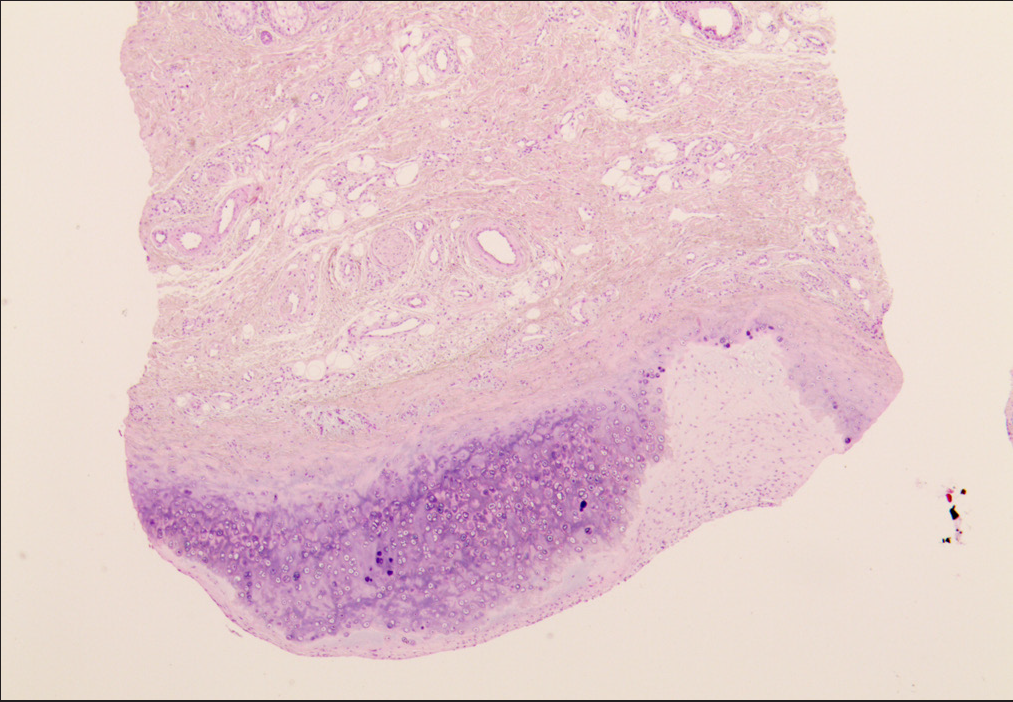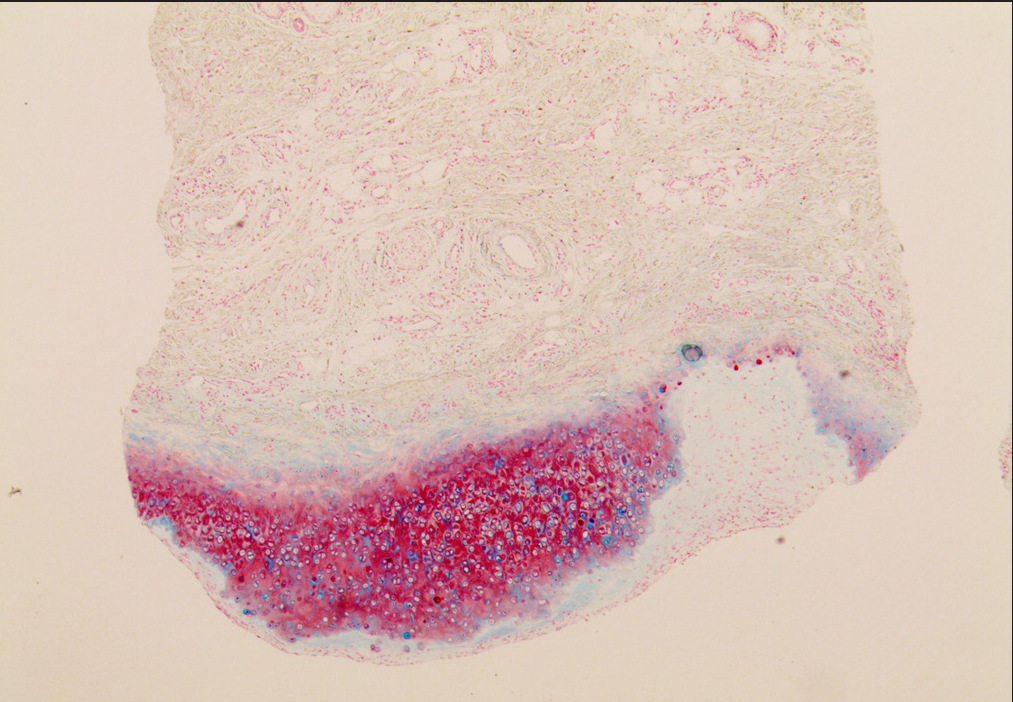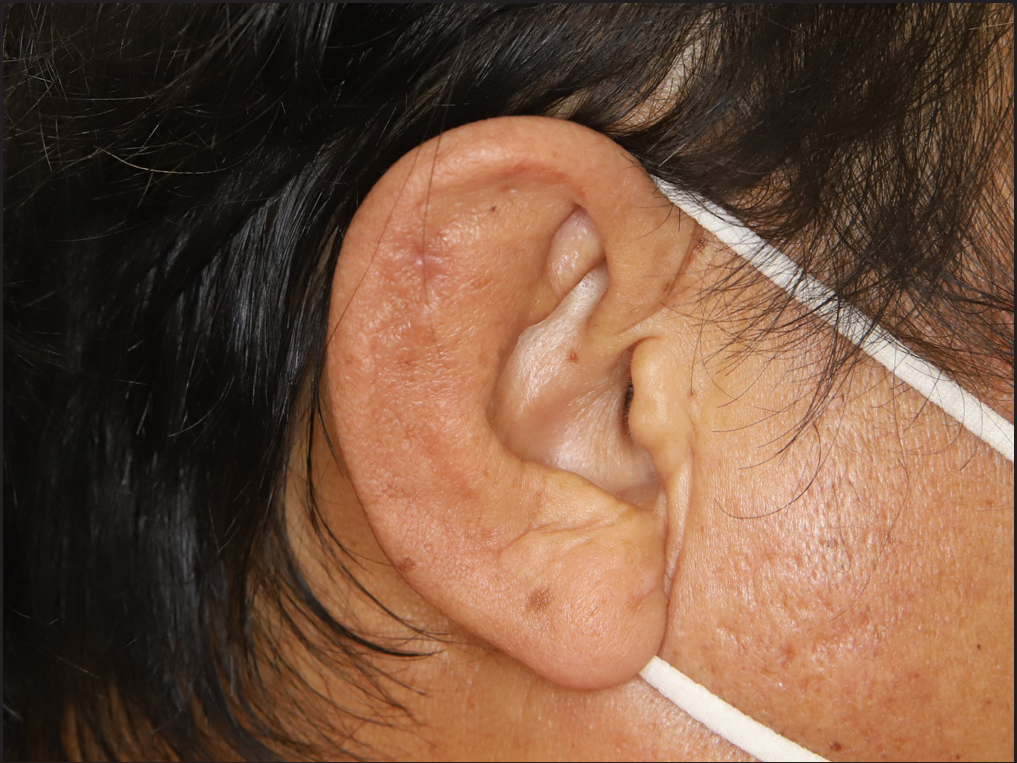Translate this page into:
Pseudocyst of the auricle treated with intralesional sodium tetradecyl sulphate injection
Corresponding author: Dr. Chul Woo Kim, Department of Dermatology, Kangdong Sacred Heart Hospital, Hallym University College of Medicine, 150, Sungan-ro, Gangdong-gu, Seoul, Republic of Korea. 937121@kdh.or.kr
-
Received: ,
Accepted: ,
How to cite this article: Chun EJ, Chung HC, Kim SS, Kim CW. Pseudocyst of the auricle treated with intralesional sodium tetradecyl sulphate injection. Indian J Dermatol Venereol Leprol. 2024;90:113-4. doi: 10.25259/IJDVL_208_2023
Dear Editor,
A pseudocyst of the auricle is a rare benign cystic swelling that usually presents on the anterior surface of the ear. Various treatments have been used so far.1–4 Here we report a case of pseudocyst of the auricle treated with intralesional sodium tetradecyl sulphate injection.
A 58-year-old man presented with an asymptomatic, coin-sized soft mass on his right ear that had occurred a month ago [Figure 1]. He had no history of preceeding trauma or any abnormal findings on neurological examination. A punch biopsy was performed, and microscopic examination revealed an intra-cartilaginous cystic cavity without an epithelial lining [Figure 2a]. It was surrounded by degenerative cartilage and contained mucin [Figure 2b]. Therefore, we diagnosed the patient with a pseudocyst of the auricle.

- Coin-sized soft cystic swelling on the scapha of the right ear.

- Intra-cartilaginous cystic cavity without a true epithelial lining (H&E, ×40).

- Mucin around the cystic cavity surrounded by degenerative cartilage and stained blue (Alcian blue stain, ×40).

- Complete resolution of the lesion after two injections of 1% sodium tetradecyl sulphate.
A suture was given after removing as much serous fluid as possible. However, two weeks after the biopsy, the lesion site swelled again. We decided to perform an intralesional sodium tetradecyl sulphate (1%) injection because the patient had fear of steroids. Despite being performed without local anaesthesia, the patient did not complain of much pain. One month later, the lesion had decreased by approximately 70%. A second injection was performed in a similar manner. After one month, the lesion had completely resolved [Figure 3]. The patient was satisfied cosmetically, and the treatment was terminated. No recurrence or side effect was noted at six months follow up visit.
A pseudocyst of the auricle is a benign, spontaneous and painless swelling that typically occurs in the scaphoid or triangular fossa.1,2 It occurs mainly in young adults and males.1 Pseudocyst fluid shows elevated interleukin 1 (IL-1), inhibited by estradiol and progesterone and elevated by testosterone. Therefore, it is thought to be prevalent in males due to differences in these hormonal cytokine inductions.5 It is considered that there is no racial predisposition, although there are many reports in Asians, especially Chinese.6 The exact cause of pseudocysts of the auricle is not yet known, but two hypotheses have been proposed.1–3 First, lysosomal enzymes released by chronic mild trauma induce cartilage degeneration and pseudocyst formation. The second possible cause is congenital embryonic dysplasia of the auricular cartilage. Diagnosis is based primarily on clinical characteristics, but it should be differentiated from diseases such as hematoma, cellulitis and relapsing polychondritis. Histologic examination shows an intracartilaginous cyst lacking a true epithelial lining; hence, the term ‘pseudocyst’. Thinned cartilage, degeneration of hyaline and granulomatous changes have also been observed.3
Although diverse non-invasive methods are used to treat pseudocysts of the auricle, there is no gold standard. Table 1 shows the advantages and disadvantages of each treatment. Sodium tetradecyl sulphate, a detergent sclerosant, that promotes the destruction of intrachondral cystic cavity walls and fibrosis after an inflammatory response has few side effects at low concentration.3,7
| Author | Method | Advantage | Disadvantage |
|---|---|---|---|
| Agrawal et al. (2020)4 | Aspiration |
Simple Cost-effective |
Possibility of recurrence |
| Parajuli et al. (2020)2 | Intralesional steroid injection | Simple |
Deformity Skin thickening Atrophy of auricular cartilage Skin pigmentation |
| Paul et al. (2001)1 | Pressure dressing after drainage | Simple | Discomfort in daily life |
| Lee et al. (2013)3 | Intralesional sodium tetradecyl sulphate injection |
Simple Cost-effective |
Pain Ulceration |
Injection of intralesional sodium tetradecyl sulphate is a simple and inexpensive treatment that can produce excellent results without major side effects, and we suggest using it as a treatment for pseudocysts of the auricle. It is meaningful to report this case because the treatment of pseudocysts of the auricle using intralesional sodium tetradecyl sulphate is not widely known yet, and there is limited literature available on its use.
Declaration of patient consent
Patient’s consent not required as patients identity is not disclosed or compromised.
Financial support and sponsorship
Nil.
Conflicts of interest
There are no conflicts of interest.
References
- Pseudocyst of the auricle: diagnosis and management with a punch biopsy. J Am Acad Dermatol. 2001;45:S230-2.
- [CrossRef] [PubMed] [Google Scholar]
- Treatment of auricular pseudocyst with intralesional steroid: A study with short-term follow-up. Clin Cosmet Investig Dermatol. 2020;13:579-85.
- [CrossRef] [PubMed] [PubMed Central] [Google Scholar]
- Successful treatment of a pseudocyst of the auricle using intralesional sodium tetradecyl sulfate injection. Dermatol Surg. 2013;39:1938-40.
- [CrossRef] [PubMed] [Google Scholar]
- Pseudocyst of auricle-an uncommon condition and novel approach for management. Indian Dermatol Online J. 2020;11:789-91.
- [CrossRef] [PubMed] [PubMed Central] [Google Scholar]
- Pseudocyst of pinna: a recurrence-free approach. Am J Otolaryngol. 2009;30:73-9.
- [CrossRef] [PubMed] [Google Scholar]
- Pseudocyst of the auricle in patients with movement disorders: report of two patients with ataxia-associated auricular pseudocysts. Dermatol Pract Concept. 2015;5:59-64.
- [CrossRef] [PubMed] [PubMed Central] [Google Scholar]
- Sodium tetradecyl sulfate: A review of clinical uses. Dermatol Surg. 2017;43:1313-20.
- [CrossRef] [PubMed] [Google Scholar]






